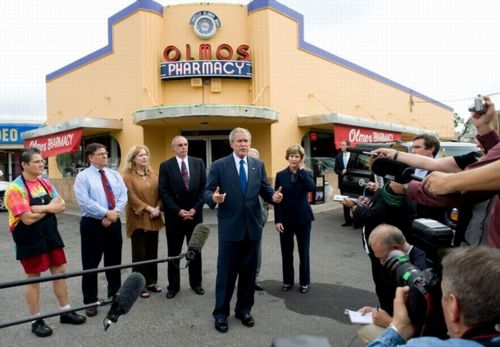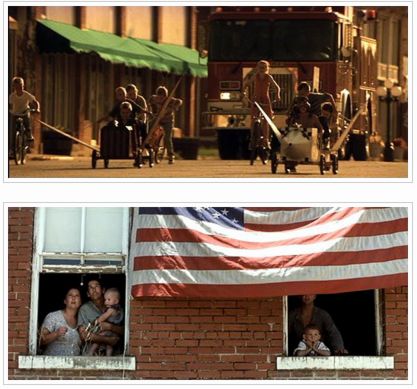“She could be the most natural, visionary poet since William Blake.”
I would lose the comma; isn’t “visionary poet” a job title all its own? [via TMN]
Category: scott sforza, wh producer
The Saddest Photo-Op
a friendless GWB at last week’s G20 summit, set to sad music. [via gawker]
You Better Hold On, Meet You In Tompkins Square
In 1988, a police riot broke out at Tompkins Square Park in the East Village. Police beat, among others, people defying a 1 AM curfew imposed by Mayor Ed Koch in an attempt to curtail, among other things, late night music performances.
Last night, twenty years later, the residents of St. Marks and Avenue A had their sleep disrupted once again by an impromptu performance at 2 in the freakin’ morning. Fortunately, the incident was caught on tape. [via sullivan]
Lemme Tell Ya Story ‘Bout A Man Named Todd
Palin screenwriters take note: the industrious reporters at Newsweek have spotted you an easy 100 points on your Scene and Dialogue Plausibility Test. Also, bonus shower scene!:
Hackers and Spending Sprees [newsweek]
Drunk Floridians For Obama
Heh. My friends, this is drunk dialing we can believe in. [macdaddyworld via sullivan]
That’s Not A Sforzian Background We Can Believe In
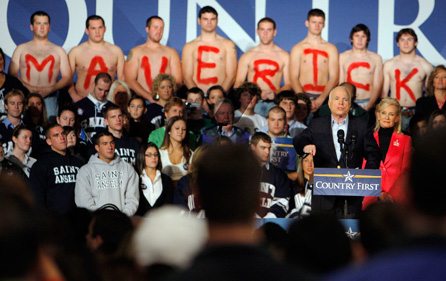
Just because you read the syllabus for Sforza 101 doesn’t mean you get credit for taking the course.
The secret of the human wallpaper backdrop is that it works best if you have either uniformed military or a racially diverse audience.
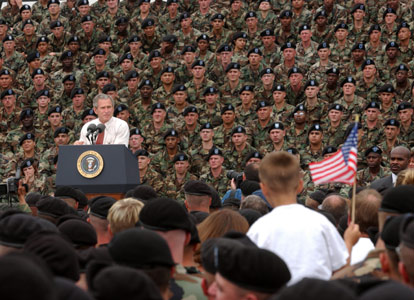
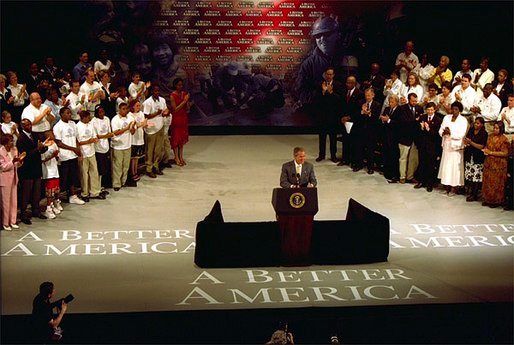
Guess those weren’t available.
[image: reuters/bryan snyder via salon]
Schoolhouse Rock The Vote
Awesome and funny. Or, I would like it to be funny on November 5th, anyway:
[via sullivan]
Sarah Palin’s Shopping Spree Is So September 10th
OK, I started picking at Politico’s $150,000 Palin Family shopping spree on Daddy Types. There was an obviously inaccurate claim that the GOP had spent $295 on a sweet ride for Trig Palin at a baby store called Steiniauer & Stroller. Now I know you can’t get a sweet stroller or $300, so I was skeptical.
Turns out Steinlauer & Stoller is a sewing supply store in New York City. The RNC must use a receipt scanner to put together their monthly Schedule F form detailing all their expenses. [via josh green at the atlantic]
And this whole $4,900 for Todd Palin’s clothes at Atelier, “a high-class shopping destination for men”? Uh-uh.
Turns out the address of Atelier is not in Minneapolis, but “7th & 47th, New York.” There is nothing high-class about that neighborhood at. all. If Atelier were a store, it’s a crappy Going Out Of Business NOW! suit mill. I’m sure it’s not a coincidence, though, that Atelier Designers, a trade show of women’s fashion designers, was ensconced in seven floors of the Doubletree Inn–at the corner of 7th & 47th.
Some things don’t add up, though; Atelier ’09 was showing spring collections, not fall [aka campaign season]. And though the official dates for the show were Sept. 13-15, during Fashion Week, the RNC’s receipt has a date of 9/10/2008.
But Sept. 10th is also the date given for the big $75,000 Neiman Marcus spree in Minneapolis, which clearly outfitted the Palin clan for their appearance on stage Sept. 3rd.
And Sept. 10th is also the date given for the campaign’s $98 purchase at Pacifier, the Minneapolis baby store where I confirmed the RNC shopped on Sept. 3rd.
So more likely Sep. 10th was the day McCain campaign official Jeff Larson handed off his previous week’s receipts. Which still leaves a bit of mystery what “campaign accessories the RNC bought on Sept 3 at a trade show that wasn’t taking place for another two weeks. Perhaps some campaign staffer’s sister was debuting her collection of handpainted scarves and got a little help paying for her trade show booth?
McCains For Obama
No one can argue slavery had an upside, but this Wall Street Journal video is about as good as it gets.
Some Of McCain’s Black Relatives Support Obama [South Florida Times via wonkette]
“Possible” By Jonathan Hoefler For Artists For Obama
“For as long as I live, I will never forget that in no other country on earth is my story even possible.”
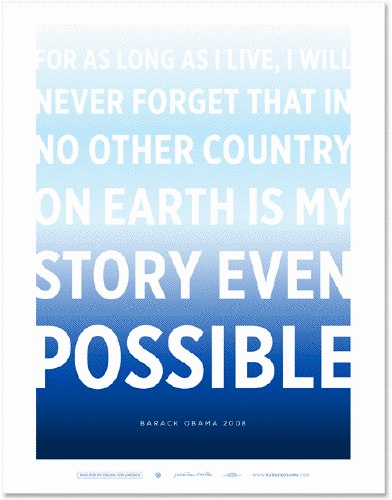
I just bought Jonathan Hoefler’s poster from the Barack Obama store. If you hurry, 4799 more of you can do the same.
“Possible” by type designer Jonathan Hoefler, $60 donation [store.barackobama.com via daringfireball]
Bruce Willis Type For President?
Two essays, each interesting and thoughtful on its own, crossed my desk this morning. I think they’re inter-related.
First from the always spatially aware Geoff Managh on the seemingly irrational landscapes of presidential campaigning:
…President Bush had stopped off this morning to speak about the credit crisis “with consumers and business people at Olmos Pharmacy, an old-fashioned soda shop and lunch counter” [1] in San Antonio, Texas.
The idea here – the spatial implication – is that Bush has somehow stopped off in a landscape of down-home American democracy. This is everyday life, we’re meant to believe – a geographic stand-in for the true heart and center of the United States.
But it increasingly feels to me that presidential politics now deliberately take place in a landscape that the modern world has left behind. It’s a landscape of nostalgia, the golden age in landscape form: Joe Biden visits Pam’s Pancakes outside Pittsburgh, Bush visits a soda shop, Sarah Palin watches ice hockey in a town that doesn’t have cell phone coverage, Obama goes to a tractor pull.
It’s as if presidential campaigns and their pursuing tagcloud of media pundits are actually a kind of landscape detection society – a rival Center for Land Use Interpretation – seeking out obsolete spatial versions of the United States, outdated geographies most of us no longer live within or encounter.
…
All along they pretend that these landscapes are politically relevant.
Then there was Matthew Dessem’s perceptive and awesome explication of The Criterion Collection’s seemingly inexplicable inclusion if Jerry Bruckheimer and Michael Bay’s 1998 oil-drillers [!] turned-astronauts-save-the-world disaster epic, Armageddon–which quotes the much-missed David Foster Wallace:
Critics who thought Armageddon was a sort of terminal end point for filmmaking (which is to say, all of them except David Edelstein, as far as I can tell) missed the point. Janet Maslin, for example, wrote, “Armageddon tries to tell a coherent story of guts, young love and space travel.” But I don’t think it does try; it’s not really interested. You wouldn’t criticize Star Tours or Batman: The Ride for shoddy characterization or wooden acting, and it doesn’t seem fair to me to treat movies like Armageddon as though their writers and directors had the same goals as, say, Tarkovsky. David Foster Wallace put it best (in “David Lynch Keeps His Head”):
Art film is essentially teleological; it tries in various ways to “wake the audience up” or render us more “conscious.” (This kind of agenda can easily degenerate into pretentiousness and self-righteousness and condescending horsetwaddle, but the agenda itself is large-hearted and fine.) Commercial film doesn’t seem like it cares much about the audience’s instruction or enlightenment. Commercial film’s goal is to “entertain,” which usually means enabling various fantasies that allow the moviegoer to pretend he’s somebody else and that life is somehow bigger and more coherent and more compelling and attractive and in general just way more entertaining than a moviegoer’s life really is…
…
The level of personal wish fulfilment in Armageddon is pretty easy to pick out; it’s worth noting that Michael Bay also sells a kind of national wish fulfilment. Armageddon has a serious hard-on for the early days of the space program, specifically for the sense of national purpose it gave the country. In fact, the movie suggests that that America, that national conception of ourselves, is still pretty much what we are, as you can see below.
In case you miss it, this shot is immediately followed by one of the astronauts saying “Kennedy, we see you. And you never looked so good!” Of course, he’s talking about the Kennedy Space Center…or is he? The point is, these sections are shamelessly manipulative and there’s nothing delicate about them. Nevertheless, they have an elegiac tone that’s more moving than anything else in the movie. And they seem motivated by a genuine longing for a national purpose, and national heroes, for a more innocent version of America. Of course, that America never really existed, and Armageddon offers Bruce Willis as just the sort of national hero we’re looking for, but hey, you take your pleasures where you find them…
Which makes me think that complaining about the irrelevance of political space is like critiquing the incoherence and narrative of Armageddon. The landscapes of the American political blockbuster are designed to provide wish fulfillment and a sense–however fictional or misguided–of “national purpose”–and ultimately, of a “national hero.”
As this remarkable montage of the US president [2] addressing the world shows, the common landscape of Armageddon‘s politics is the flat, square–and as Dessem points out, time zone-free–space of the television screen:
Minor Landscapes and the Geography of American Political Campaigns [bldgblog via city of sound]
#40: Armageddon [criterioncollection via goldenfiddle]
[1] as the photo shows and a bldgblog commenter points out, Olmos Pharmacy has actually been reinvented as Olmos Bharmacy, “a combination soda fountain counter and wine bar.”
[2] For a second I was worried, but then I realized that it was the other 1998 space-object-destroys-the-earth movie, Deep Impact that had the black president.
Etsy Sellers For Obama?
There are a few folks with Magritte-esque, absurdist posters outside the Vice Presidential debate tonight. Though, “Mo’ Monkeys, Mo’ Problems” is sweet, I think it unfairly singles out monkeys. So my favorite is “This is an owl.”
What does it say about the election mediascape that a dadaist poster stunt could just as easily be a dog whistle for some invisible target demographic as a marketing tool for goldenpalace.com? Though there’s not a URL to be seen.
We’re All David Lettermans Now
John McCain lied to David Letterman, and Letterman is pissed.
John McCain called Letterman personally to cancel his appearance on the show last night, claiming he was rushing right back to Washington to save the economy. Then he went to do an interview with Katie Couric.
This is not Sforza we can believe in.
A School Called Hope
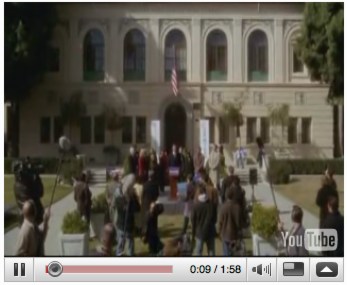
“This is the place that matters.” And this just gets better and better. Walter Reed Middle School served as the backdrop for the presidential candidacy of Democratic congressman Matt Santos–as played by Jimmy Smits on West Wing.
West Wing producer-writer Eli Attie told the Guardian in February that the Santos character was based on Barack Obama:
“I drew inspiration from him in drawing this character,” West Wing writer and producer Eli Attie told the Guardian. “When I had to write, Obama was just appearing on the national scene. He had done a great speech at the convention [which nominated John Kerry] and people were beginning to talk about him.”
Attie, who served as chief speechwriter to Al Gore during the ill-fated 2000 campaign and who wrote many of the key Santos episodes of the West Wing, put in a call to Obama aide David Axelrod.
“I said, ‘Tell me about this guy Barack Obama.'”
Axelrod is, of course, Obama’s chief strategist for the campaign.
Watch Santos’ hope-themed speech [youtube via tpm]
From West Wing to the real thing | Scriptwriters modelled TV’s ethnic minority candidate on young Barack Obama
[guardian.co.uk]
Live By The Sforza, Die By The Sforza?
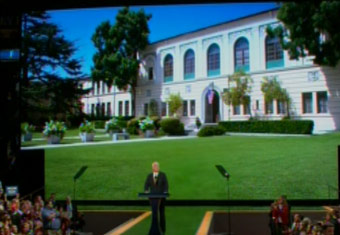
As a student of Sforzian backdrops, this scenario being discussed here is almost too… and yet…
Did the GOP really use:
– an image of the main building at Walter Reed
– only it’s not the Army’s Walter Reed Medical Center but
– Walter Reed Middle School in North Hollywood
– that looks like a giant Mediterranean-style mansion, perhaps the McCain’s place in Palm Beach?
– And which has a giant green lawn
– that ends up recreating the horrible green backdrop of McCain’s speech the night Obama took the nomination?
– and which has been used as a location for filming Malcolm in the Middle, Growing Pains, and Transformers?
It’s like the Sforzian equivalent of blinking out a secret message in Morse code: O-B-A-M-A.
related? A WSJ profile of McCain’s creative director and the guy responsible for “the planning of the program and the production of the videos shown [at the convention],” “Hollywood” Fred Davis [wsj.com]

